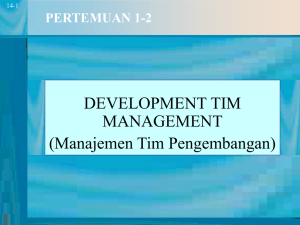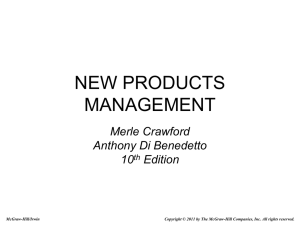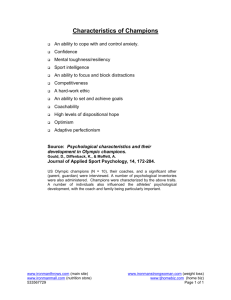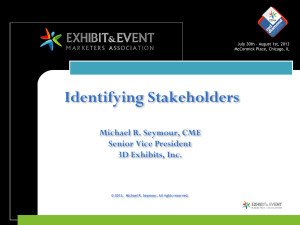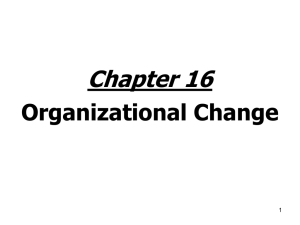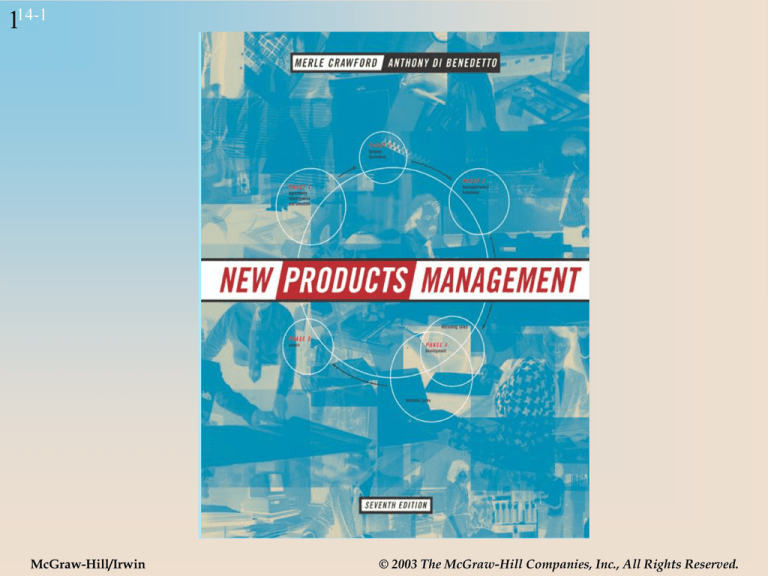
114-1
McGraw-Hill/Irwin
© 2003 The McGraw-Hill Companies, Inc., All Rights Reserved.
214-2
CHAPTER FOURTEEN
DEVELOPMENT TEAM
MANAGEMENT
314-3
Some Terms in New Products Organization
• Functional: People in business departments or
functional areas are involved, and product
development activity must mesh with their work.
• Project: The product innovation activity requires
people who think first of the project.
• Matrix: Two people are likely to be involved in any
piece of work: project manager and line function
head.
414-4
Options in New Products Organization
Figure 14.1
1. Functional
2. Functional Matrix
3. Balanced Matrix
4. Project Matrix
5. Venture
These are listed in increasing projectization, defined as
the extent to which participants see themselves as
independent from the project or committed to it.
514-5
Options in New Products Organization
1. Functional: work is done by the various departments, very little
project focus.
– Usually a new products committee or product planning
committee.
– Does not lead to much innovation.
2. Functional Matrix: A specific team with people from various
departments; project still close to the current business.
– Team members think like functional specialists.
– Departments call the shots.
614-6
Options in New Products Organization
3. Balanced Matrix: Both functional and project views are
critical.
– May lead to indecision and delay.
– Many firms are making it work successfully.
4. Project Matrix: High projectization, team people are
project people first and functional people second.
– People may drive the project even against department’s
best wishes.
– IBM PC developed this way.
5. Venture: Team members pulled out of department to work
full time on project.
714-7
Performance Success of the Five
Organizational Options
Similar results found for the teams’ ability to: meet schedule;
control cost; achieve technical performance
Figure 14.3
814-8
Figure 14-4
Operating Characteristics of the Basic
Options
Characteristic
Functional <------------->Venture
Decision Power of Leader
Low
High
Independence of Group
Low
High
% of time spent on project by member
Low
High
Importance of Project
Low
High
Degree of risk of project to firm
Low
High
Disruptiveness of project
Low
High
Degree of uncertainty
Low
High
Ability of team to violate
company policy
Low
High
Independent funding
Low
High
914-9
Decision Rules for Choosing
Among the Options
Score each on a scale of 1 (low) to 5 (high):
1. How difficult is it to get new products in the firm?
2. How critical is it for the firm to have new products at this time?
3. How much risk to personnel is involved?
4. How important is speed of development?
5. Will the products be using new procedures in their manufacturing?
6. In their marketing?
7. What will be the $ profit contribution from each new item?
8. How much training do our functional people need in the markets
represented by the new products we want?
Rating: Below 15: functional matrix will likely work.
15-30: a balanced matrix will probably work.
Over 30: You need a project matrix or even a venture!
Figure 14.5
14-10
10
Another View:
Home Runs Vs. Singles
Characteristics of “home run” projects:
• Distance from regular business -- markets, technologies, distribution
system.
• Conflicts with regular business -- success will threaten people in the
organization’s regular business (production, sales, technical).
• Major financial importance -- dollars, risk, or (especially) both.
• Timing -- a project that may be a “single” in normal times -competition, market change, threatened acquisition, insecure
management team, shortage of new product projects.
(Do the opposite conditions make for singles?)
The more like a “home run” a project is, the more it
is suited to a more projectized organizational structure.
14-11
11
Considerations when Selecting an
Organizational Option
Figure 14.6
• High projectization encourages cross-functional integration.
• If state-of-the-art functional expertise is critical to project success
(e.g., in a scientific specialty), a functional organization might be
better, as it encourages the development of high-level technical
expertise.
• If individuals will be part of the project for only a short time, it
might make more efficient use of their time if they were organized
functionally. Industrial designers may be involved in any given
project for only a short time, so different projects can simply draw on
their expertise when needed.
• If speed to market is critical, higher projectization is preferred as
project teams are usually able to coordinate their activities and
resolve conflicts more quickly and with less bureaucracy.
14-12
12
Who Are the Team Members?
• Core Team: manage functional clusters (e.g.,
marketing, R&D, manufacturing)
– Are active throughout the NPD process.
• Ad Hoc Group: support the core team (e.g.,
packaging, legal, logistics)
– Are important at intervals during the NPD
process.
• Extended Team Members: less critical
members (e.g., from other divisions)
14-13
13
Participants in the Product Management
Process
Figure 14.7
• Project Manager
– Leader, integrator, mediator, judge
– Translator, coordinator
• Project Champion
– Supporter and spokesperson
– May be the project manager
– Enthusiastic but play within the rules
• Sponsor
– Senior executive who lends encouragement and
endorsement to the champion
• Rationalist
– The “show-me” person
14-14
14
Participants in the Product Management
Process
Figure 14.7
(cont’d.)
• Strategist
– Longer-range
– Managerial -- often the CEO
– Spelled out the Product Innovation Charter
• Inventor
– Creative scientist
– “Basement inventor” -- may be a customer, ad agency person,
etc.
– Idea source
• Facilitator
– Enhance team’s productivity and output
14-15
15
Myths and Truths About Product
Champions
Figure 14.8
The Myths:
The Truths:
• Champions are associated
with market successes.
• Champions are excited about
the idea.
• Champions get involved
with radical changes.
• Champions arise from high
(or low) levels in the firm.
• Champions are mostly from
marketing.
• Champions get resources
and keep projects alive.
• They are passionate,
persuasive, and risk-taking.
• Champions work in firms
with or without formal new
product processes.
• Champions are sensitive to
company politics.
• Champions back projects
that align with the firm’s
innovation strategy.
14-16
16
Guiding Principles in New Product Process
Implementation
Figure 14.10
Clarity of Goals and Objectives
Ownership
Leadership, at both senior and team levels
Integration with business processes
Flexibility
14-17
17
Issues in Team Management
• Team compensation and motivation
– Monetary vs. non-monetary rewards?
– Process-based vs. outcome-based rewards?
• Closing the team down

